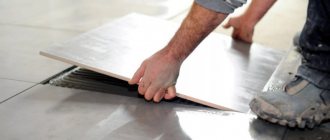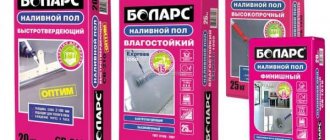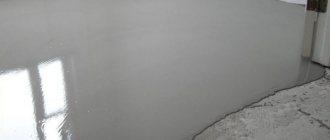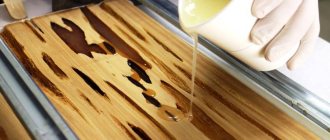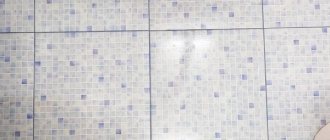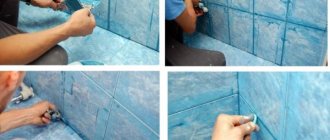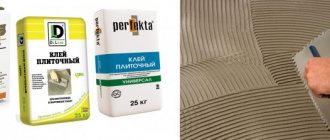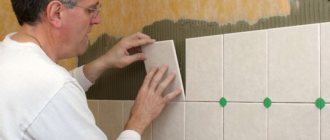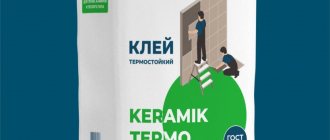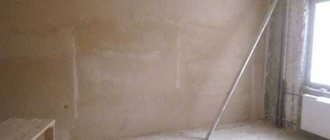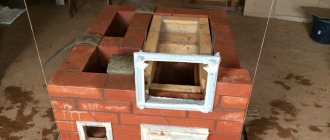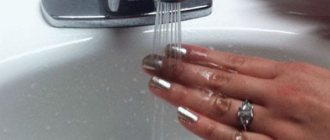What parameters does polymerization depend on?
There are three main parameters in assessing the drying speed of tile adhesive:
- Temperature indicator indoors and outdoors. If it's hot outside, the solution will dry faster. At low rates the opposite is true.
You should not carry out cladding at temperatures below 5 degrees, this applies to working with frost-resistant mixtures.
It is determined that in summer the polymerization period is 24–36 hours, in winter – 36–48 hours.
- Temperature indicator of the base. Sometimes its value is lower than the overall temperature in the room. This increases the time required for complete drying. The optimal temperature is +20 degrees.
- Humidity indicator. It has been determined that the higher the humidity, the longer the glue dries. But the importance of the room is taken into account.
In addition, polymerization depends on the thickness of the applied adhesive layer. A thick layer takes much longer to dry. The optimal amount of consumption is described on the packaging. Based on this data, it is better to make masonry.
The preparation of the base is often neglected, and the tile paste serves as a leveling component. In this case, uneven application of the solution is observed, which leads to different drying rates in different areas.
The type of adhesive also affects the drying time of the tile adhesive. Additional components and additives improve the quality of the solution. Fast-drying, high-strength, harden faster.
The rate of water absorption of the base affects the rate of drying. Porcelain tiles are waterproof, just like a concrete base. With this combination of bases, drying time increases.
Interesting video on the topic:
Test methods: how long does it take for floor tiles to dry after installation?
There is no way to determine if the floor surface is dry. You can only try to detach one tile. If the tile moves, then the required drying time has not yet passed. In this case, you shouldn’t walk, otherwise you may not give the tile a chance to stick at all.
But you can identify the tiles that are not stuck to the floor at all or which have come off. To do this, you need to knock on the tile a little. A duller sound indicates voids.
Try to allow more drying time than indicated in the table on the mixture packaging
What to do with loose tiles:
- With maximum care, separate it from the base;
- Clean off any remaining adhesive;
- Using new glue, reattach the tile.
In this case, you must follow the instructions exactly and do not walk on the tiles ahead of time. Even if you are absolutely sure that the floor is dry, it is better to wait another half a day. After this, you can begin further work with the flooring, jointing the seams.
How long does it take for it to dry on the floor?
They are trying to put the floor into operation faster, which without completely drying the masonry will lead to the formation of defects. The tile mass dries on the floor for about a week, which depends on a number of indicators (humidity, temperature, type of base, mixture, etc.).
If the screed is cement-sand, then the strength of the installation is achieved after 3 days.
Grouting of joints is carried out through the gap indicated on the glue packaging. If the work is done ahead of schedule, the tile material will shift or damage will occur.
Factors influencing curing time
They are numerous and varied.
At high humidity, the installation time increases by 5-10 minutes, and readiness for grouting shifts by 6-12 hours.
Severely low humidity (especially in drafts) dries out the top open layer of the mortar, making installation faster.
Temperature
The temperature of the base should not be below 0 (frozen).
48 hours before installation, the “warm floor” must be turned off.
Air temperature affects all stages of glue drying:
– low – prolongs time,
– high – reduces.
In the instructions, manufacturers indicate a table of correspondence between the size of the tile and the height of the teeth of the spatula used: the larger the area of the product, the thicker the layer of the adhesive mixture.
Applying the solution manually with a spatula
Possible consequences of choosing the wrong spatula:
- loss of strength of a thin layer (moisture is quickly absorbed and hardens without having time to gain strength),
— displacement of the tile position (a 10 mm layer with an uneven base gives different shrinkage). Typically a spatula with a tooth of 10-14 mm is used, creating a layer 4-6 mm thick.
Quick application of the solution using a mechanical device
Drying time on walls
The drying time of the tile mixture on the walls also depends on a number of indicators - preparation of the base, the mixture used, air temperature, size of the tile.
Before laying the tiles, it is necessary to level the walls with plaster or adhesive.
Typically, reinforced or universal mortars are used for wall cladding, which quickly set and prevent the tiles from sliding off the vertical plane.
Moisture-resistant masses harden within 24 hours, reinforced ones faster in 12–20 hours, some universal ones in 10 hours, frost-resistant ones - 36 hours.
Types of adhesives
Most modern tile adhesives require a drying time of 12 to 24 hours. This interval is determined by the components included in the glue.
Types of adhesives
Thus, universal tile adhesive solutions dry within 7 hours, and finally gain strength after 12 hours.
Types of adhesives for tiles
A more serious drying time (from 12 to 24 hours) is required for adhesives with a reinforced binder, which are used for large format tiles or porcelain stoneware.
Laying porcelain tiles
When laying tiles outside, frost-resistant tile adhesive is used, which may take up to 36 hours to dry.
Porch tiling
For floor coverings in rooms with high humidity - in baths, saunas, swimming pools, an adhesive solution with increased moisture protection is used to fix the tiles, which dries within 24 hours.
Flooring in the bathhouse
When using “white glue”, which fixes mosaic coverings and glass blocks, the drying time is at least 36 hours.
Mosaic floor in the bathroom
Curing period of various types
The market offers a range of required formulations, which are divided into types depending on the included additives:
- Universal. Mainly used for indoor work. If the conditions and layer thickness are met, the mixture sets in 8 hours.
- Reinforced. It is used when facing materials of large sizes. Complete hardening occurs within a day.
- Frost-resistant. For masonry work on the outside of the building. The layer dries completely after 36 hours.
- Moisture resistant. For cladding work in swimming pools, bathrooms, bathhouses. The composition includes an antiseptic additive.
When calculating the hardening time, it is necessary to take into account the work on grouting the joints and their drying time.
In order to more accurately calculate the hardening time of the solution, when purchasing, you need to take into account the composition, scope of application, and all the described characteristics.
The importance of complete drying
Only inexperienced craftsmen start grouting without waiting for it to harden. Ignoring this rule leads to poor adhesion and deformation of the coating.
Unaesthetic seams will force re-installation. Even if you are confident, it is not a bad idea to play it safe and reschedule the grouting work to the next day.
Glue drying chart of popular manufacturers
The hardening time is influenced by the properties of the mass and its composition. There are mixtures on the market with similar and different characteristics.
The table shows the drying rates of tile adhesives from popular manufacturers:
Data for quick-drying types are presented in the following table:
The specified data is indicative and is used when working in normal temperature conditions (20–22 degrees) and air humidity.
What is the drying interval for tiles?
More precisely, it depends on the conditions in which the installation is carried out, on the temperature, air humidity, the thickness of the adhesive layer and on the glue itself.
On the packaging, the manufacturer indicates the hardening time under the most optimal conditions, but in real life, these criteria are sometimes very difficult to achieve. Therefore, the drying time for your tile varies individually.
Is it worthwhile to observe the drying time interval so carefully? And is it really that important? Of course this is extremely important and necessary. Because if you don’t wait until it hardens completely, you can simply ruin everything - from deformation of the tile to its complete destruction.
How to determine the degree of drying of glue
There is no single, universal method for determining the degree of drying of glue.
You can use the tile tearing method. This action is performed carefully using narrow material. In an inconspicuous place (preferably a corner part), lift the tile with a spatula. If the removal occurred immediately, then the solution did not set and the coating cannot be used.
The second method is tapping. To do this, use a rubber hammer or a wooden hammer holder. How to determine the degree of drying by the sound produced: a dull sound is characteristic of a damp layer, ringing for a frozen one.
The tapping method is used to identify installation defects. A very ringing sound indicates that a tile is coming loose and needs to be repositioned.
Useful tips
Many people try to make repairs not only quickly, but also not very well, being lazy, for example, dismantling the old coating. You absolutely cannot do this.
No one lays new tiles on top of old ones, because the adhesive may not adhere or even deteriorate from such a laying.
- If you are preparing a surface, for example, you are making a self-leveling floor, you need to remember that it also needs to be given time to dry.
- This will take at least a day. Many manufacturers write that you can walk on the self-leveling floor after 2 hours after application.
- It is not true. The composition may set, but not completely harden, so it will deform. And the time for complete hardening will increase.
How to speed up the process
You should not resort to radical measures to quickly dry the tile material in order to put the plane into operation. Rapid drying will lead to peeling of the tiles and the appearance of defects.
For more gentle acceleration, install a fan near the open door of the room. The power of the wind flow should be minimal.
To speed up the hardening process of the mortar layer, the “warm floor” system is not used. It will lead to cracking of the facing plane.
The main thing is that the drying process proceeds favorably and that the ventilation system is in good working order. If it does not work or is absent, then the door to the room should always be open.
If you don't have time to wait
Based on the study of the properties of different types of tile adhesive, as well as when considering its behavior under various environmental conditions, we can highlight the main points of accelerating the drying process.
- Raise the air temperature and reduce the humidity using a heat gun or fan heater. It is important not to overheat the room, otherwise rapid drying will cause deformation of the tile layer.
- Use quick-drying glue.
- Dilute the glue in hot water or heat the container with the solution in a water bath. In this case, the duration of the installation stage should be significantly reduced, because hot glue dries much faster.
It is prohibited to speed up the drying process when laying tiles on a “warm floor” system.
The most popular types of mixtures for tiled repairs
How long does acrylic paint dry?
They can be divided into three groups:
- Standard.
- Reinforced.
- Super.
Tile adhesive Ceresit-11 and Unis-20
- Typically, when renovating apartments, mixtures of Ceresit-11 and Unis-20 are used. For such compositions, the hardening time is about a day, and how long the tile adhesive dries on the floor depends on the temperature of the same floor. If it is low and within 5–7 °C, then it is better to let the solution dry for at least three days.
- There are enhanced tile adhesive formulations. For example, Ceresit-18 or Unis+. Such solutions set within twelve or fourteen hours. This saves a lot of time.
- The most versatile and modern compositions are superglues for finishing work. One of these mixtures is Plitonit V glue. It can be applied to any walls and floors, and can also be used for lining swimming pools and heated floors. At the same time, Plitonit is suitable for working with any type of facing materials, including porcelain stoneware and tiles made of artificial and natural stone. They can even plaster small potholes and uneven surfaces.
The advantage of this supermix is its drying speed. In the average climate zone, facing work can be completed in a day if you use Plitonit solution. Within four hours after laying the tile covering on the floor, you can carefully walk on it and grout the seams.
Tile adhesive Ceresit-18 and Unis+
The disadvantages of this mixture include its rather high price and the fact that there is little time left for adjustments. The undeniable advantages of glue include its versatility. The fact that Plitonite dries quickly allows for high-quality and efficient repairs and construction work.
During tiling work, it is also important to take into account the drying time of the grout. On average, it hardens in an hour, and after three hours it acquires full strength.
At the final stage, the tile covering is cleaned.
Crystallization of the diluted working mixture occurs quite quickly, so gluing the tiles requires some skill
When working with tiles, the master’s attention should be focused on various factors and nuances
- For example, large and heavy tiles laid on a horizontal surface can be walked on carefully if they are separated by crosses. The main thing is not to move them.
- Clay floor tiles dry faster than porcelain tiles.
Experienced tilers know that each stage of the technological process of tiling work must be completed on time. Each package of tile adhesive contains information about how long it should take to dry. Most experts, however, recommend not to rush, but to play it safe and wait longer than the manufacturer recommends. This is completely justified, since the mixture acquires maximum strength only after a week, thus you can walk on it as much as you like.
Tile adhesive layer thickness
Initially, the floors are leveled, this will save costs. Differences are possible within 1-1.5 cm. At low points, the adhesive mixture is applied in larger quantities.
By the way, thickening the layer does not increase the hardening time. The volume of liquid in the composition is directly related to its plasticity, speeding up drying, but if water is absorbed at an accelerated rate, then strength is reduced. There are self-leveling solutions that have the property of self-leveling the plane to perfect evenness.
TOP-best tile adhesive
- Unis;
- Seresit;
- Knauf.
The leading position remains with the usual sand-cement screed, to which mineral components are added that increase adhesion and reduce water release.
Residential premises are finished with just such an accessible technique, waiting for hardening after 5 days.
- The components may include epoxy resin with organic ingredients and a catalytic additive.
- This is a durable mass that is not afraid of low temperatures, moisture, and can withstand significant mechanical stress. Its only drawback is its high price.
- Dispersion adhesive includes synthetic resins and organics; it is a budget option, sold ready-made, it is plastic and hardens quickly.
Liquid nails contain rubber and polymers, but they have a pungent odor and are used only for restoration purposes.
Dependence on tile sizes
Small tiles set faster, which promises quick use. This reduces glue consumption. Large specimens are characterized by the frequent occurrence of voids, increasing the load on the adhesive base. You should not rejoice at the rapid hardening.
It is possible that the priming work was carried out with errors, and water was drawn out of the base, without providing the material with adhesion, and this is a threat of peeling.
Walking on the floor is allowed after 24 hours, but to do this the following conditions must be met:
- Shoes should have a soft sole without a heel.
- Avoid accidental falling of large objects.
- Postpone arrangement of furniture.
You can lay a plank or plywood bridge to mitigate the negative impact on the fresh surface.
The need for quality drying
Even if the glue sets, there is a risk of damage to the ceramic. The strength characteristics of the floor are acquired gradually.
The layout is as follows:
- The masonry work process takes about an hour.
- Hardening without gaining strength takes two days, after which grouting is allowed.
- Final fixation with the possibility of arranging furniture is achieved after a week, which is confirmed by professionals.
Of course, I want to finish the renovation as quickly as possible, but haste is a bad advisor. If you fail to meet the technological deadline, you will disrupt the adhesion, causing detachment, and this is a guarantee of unexpected expenses and a blow to the family budget.
